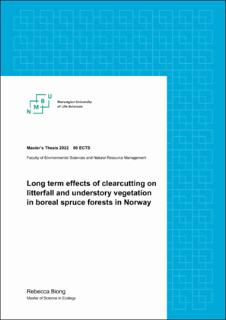Long term effects of clearcutting on litterfall and understory vegetation in boreal spruce forests in Norway
Master thesis
Permanent lenke
https://hdl.handle.net/11250/3018134Utgivelsesdato
2022Metadata
Vis full innførselSamlinger
- Master’s theses (MINA) [668]
Sammendrag
Boreal forests capture and store substantial amounts of carbon in a global perspective, and the soil is especially important acting like a long-term reservoir of captured atmospheric CO2. Most of the soil carbon originates from plant litter, shed or withered plant material, added to the forest floor and accumulated. Here, we quantify relative aboveground litter input from trees, and standing understory biomass, as well as carbon and nitrogen concentrations in different litter sources in pairs of mature clear-cuts harvested around the 1950s and near-natural stands in bilberry-spruce forests. The study is based on litter collection with litter-traps and understory biomass harvesting in nine pairs of clear-cuts and near-natural stands in south-central Norway. Our results indicate that there is more understory biomass and potentially higher inputs of aboveground understory litter in near-natural stands, especially driven by bilberry. This study provides enhanced knowledge on effects of intensive forestry practices on understory vegetation in a longer time-perspective, as well as direct measurements of carbon and nitrogen concentrations among fractions of aboveground tree litter and understory functional groups. By now there is accessible and extensive data on standing tree biomass in Norwegian forest ecosystems, but only limited empirical data on litter fluxes and concentrations of C and N from specific litter sources. More research covering long-term clearcutting effects on litterfall in boreal forests is crucial for enhancing our understanding of global carbon-flux mechanisms, as these forests cover vast areas and are profoundly affected by intensive forestry.

